![]()
![]()
![]()
Use LEFT and RIGHT arrow keys to navigate between flashcards;
Use UP and DOWN arrow keys to flip the card;
H to show hint;
A reads text to speech;
133 Cards in this Set
- Front
- Back
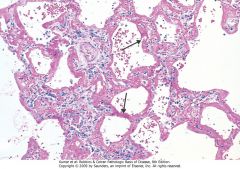
|
Diffuse alveolar damage (acute respiratory distress syndrome). Some of the alveoli are collapsed; others are distended, and many are lined by hyaline membranes (arrows).
|
|

|
A, Centriacinar emphysema. Central areas show marked emphysematous damage (E), surrounded by relatively spared alveolar spaces. B, Panacinar emphysema involving the entire pulmonary lobule.
|
|
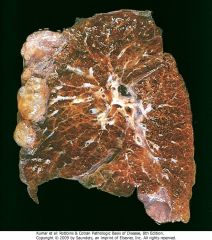
|
Bullous emphysema with large subpleural bullae (upper left).
|
|
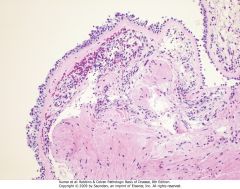
|
Bronchial biopsy specimen from an asthmatic patient showing sub-basement membrane fibrosis, eosinophilic inflammation, and muscle hyperplasia.
|
|
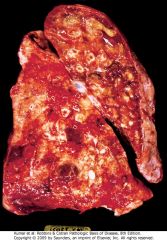
|
Bronchiectasis in a patient with cystic fibrosis, who underwent lung transplantation. Cut surface of lung shows markedly distended peripheral bronchi filled with mucopurulent secretions.
|
|
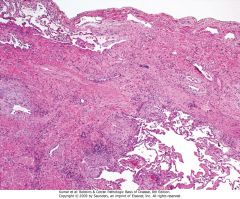
|
Usual interstitial pneumonia. The fibrosis is more pronounced in the subpleural region.
|
|
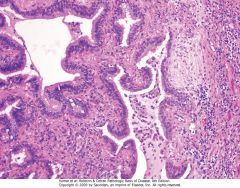
|
Usual interstitial pneumonia. Fibroblastic focus with fibers running parallel to surface and bluish myxoid extracellular matrix. Honeycombing is present on the left.
|
|

|
Cryptogenic organizing pneumonia. Some alveolar spaces are filled with balls of fibroblasts (Masson bodies), while the alveolar walls are relatively normal. A, Low power; B, high power.
|
|
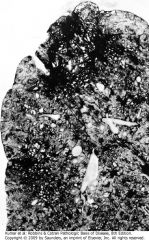
|
Progressive massive fibrosis superimposed on coal workers' pneumoconiosis. The large, blackened scars are located principally in the upper lobe. Note the extensions of scars into surrounding parenchyma and retraction of adjacent pleura.
|
|
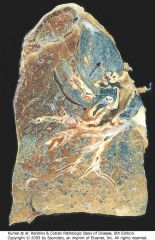
|
Advanced silicosis (transected lung). Scarring has contracted the upper lobe into a small dark mass (arrow). Note the dense pleural thickening.
|
|
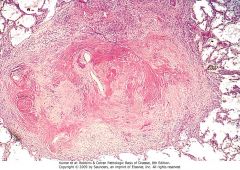
|
Several coalescent collagenous silicotic nodules
|
|
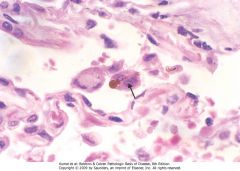
|
High-power detail of an asbestos body, revealing the typical beading and knobbed ends (arrow).
|
|
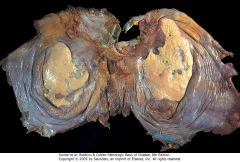
|
Asbestos-related pleural plaques. Large, discrete fibrocalcific plaques are seen on the pleural surface of the diaphragm.
|
|
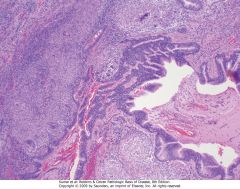
|
Characteristic sarcoid noncaseating granulomas, peribronchial, with many giant cells.
|
|
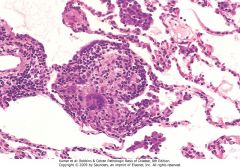
|
Hypersensitivity pneumonitis, histologic appearance. Loosely formed interstitial granulomas and chronic inflammation are characteristic.
|
|
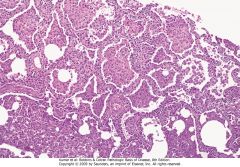
|
Desquamative interstitial pneumonia. Medium-power detail of lung demonstrates the accumulation of large numbers of macrophages within the alveolar spaces and only mild fibrous thickening of the alveolar walls.
|
|
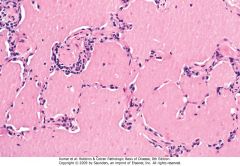
|
Pulmonary alveolar proteinosis, histologic appearance. The alveoli are filled with a dense, amorphous, protein-lipid granular precipitate, while the alveolar walls are normal.
|
|
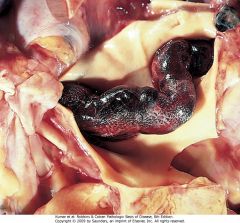
|
Large saddle embolus from the femoral vein lying astride the main left and right pulmonary arteries.
|
|
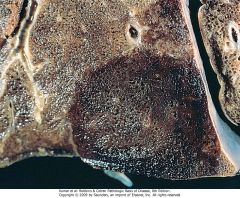
|
Recent, small, roughly wedge-shaped hemorrhagic pulmonary infarct.
|
|
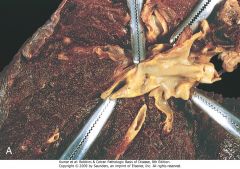
|
Vascular changes in pulmonary hypertension. A, Gross photograph of atheroma formation, a finding usually limited to large vessels.
|
|
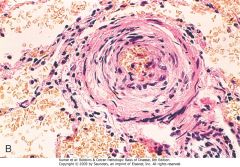
|
Vascular changes in pulmonary hypertension. B, Marked medial hypertrophy.
|
|
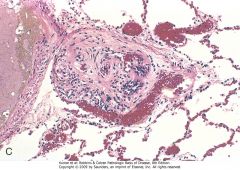
|
Vascular changes in pulmonary hypertension. C, Plexiform lesion characteristic of advanced pulmonary hypertension seen in small arteries.
|
|
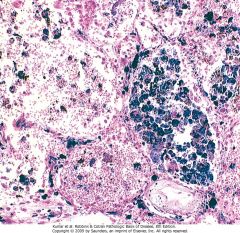
|
Diffuse pulmonary hemorrhage syndrome. Acute intra-alveolar hemorrhage and hemosiderin-laden macrophages, reflecting previous hemorrhage, are common features (Prussian blue stain for iron).
|
|
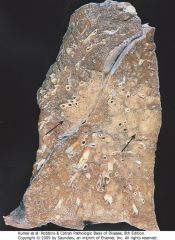
|
Bronchopneumonia. Gross section of lung showing patches of consolidation (arrows).
|
|
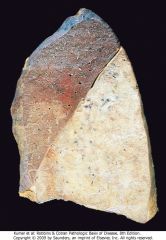
|
Lobar pneumonia-gray hepatization, gross photograph. The lower lobe is uniformly consolidated.
|
|
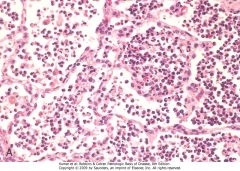
|
Stages of bacterial pneumonia. A, Acute pneumonia. The congested septal capillaries and extensive neutrophil exudation into alveoli corresponds to early red hepatization. Fibrin nets have not yet formed.
|
|
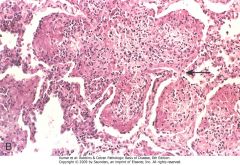
|
Stages of bacterial pneumonia.B, Early organization of intra-alveolar exudate, seen in areas to be streaming through the pores of Kohn (arrow).
|
|
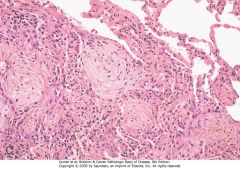
|
Stages of bacterial pneumonia. C, Advanced organizing pneumonia featuring transformation of exudates to fibromyxoid masses richly infiltrated by macrophages and fibroblasts.
|
|

|
Pyemic lung abscess (center) with complete destruction of underlying parenchyma within the focus of involvement.
|
|
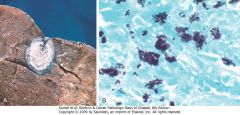
|
Histoplasmosis. A, Laminated Histoplasma granuloma of the lung. B, Histoplasma capsulatum yeast forms fill phagocytes in the lung of a patient with disseminated histoplasmosis (silver stain).
|
|

|
Blastomycosis. A, Rounded budding yeasts, larger than neutrophils, are present. Note the characteristic thick wall and nuclei (not seen in other fungi).
|
|
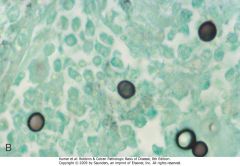
|
Blastomycosis. A, Rounded budding yeasts, larger than neutrophils, are present. Note the characteristic thick wall and nuclei (not seen in other fungi). B, Silver stain.
|
|
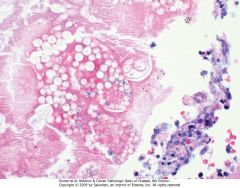
|
Coccidioidomycosis with intact and ruptured spherules.
|
|

|
Chronic rejection of lung allograft, with total occlusion of bronchiole (bronchiolitis obliterans). Adjacent pulmonary artery branch is normal.
|
|
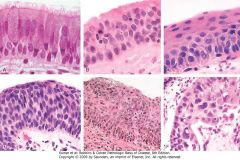
|
Precursor lesions of squamous cell carcinomas. Some of the earliest (and "mild") changes in smoking-damaged respiratory epithelium include goblet cell hyperplasia (A), basal cell (or reserve cell) hyperplasia (B), and squamous metaplasia (C). More ominous changes include the appearance of squamous dysplasia (D), characterized by the presence of disordered squamous epithelium, with loss of nuclear polarity, nuclear hyperchromasia, pleomorphism, and mitotic figures. Squamous dysplasia may, in turn, progress through the stages of mild, moderate, and severe dysplasia. Carcinoma-in-situ (CIS) (E) is the stage that immediately precedes invasive squamous carcinoma (F), and apart from the lack of basement membrane disruption in CIS, the cytologic features are similar to those in frank carcinoma. Unless treated, CIS will eventually progress to invasive cancer.
|
|
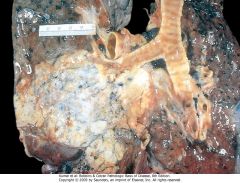
|
Lung carcinoma. The gray-white tumor tissue is seen infiltrating the lung substance. Histologically, this large tumor mass was identified as a squamous cell carcinoma.
|
|
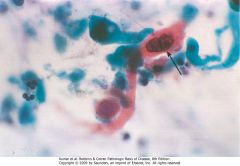
|
Cytologic diagnosis of lung cancer. A sputum specimen shows an orange-staining, keratinized squamous carcinoma cell with a prominent hyperchromatic nucleus (arrow). Note the size of the tumor cells compared with normal polymorphonuclear leukocytes in the left lower corner.
|
|
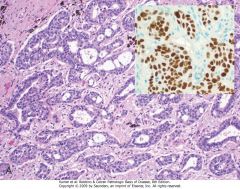
|
Histologic variants of lung carcinoma. A, Gland-forming adenocarcinoma, inset shows thyroid transcription factor 1 (TTF-1) positivity. mous or glandular differentiation.
|
|
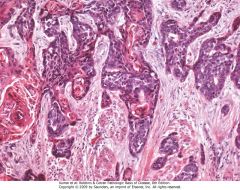
|
Histologic variants of lung carcinoma. B, Well-differentiated squamous cell carcinoma showing keratinization.
|
|

|
Histologic variants of lung carcinoma. C, Small cell carcinoma with islands of small deeply basophilic cells and areas of necrosis.
|
|
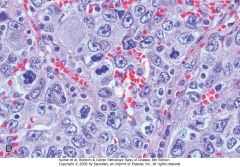
|
Histologic variants of lung carcinoma. D, Large cell carcinoma, featuring pleomorphic, anaplastic tumor cells with no squamous or glandular differentiation.
|
|
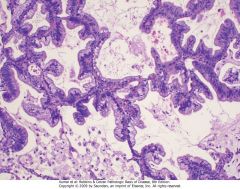
|
Bronchioloalveolar carcinoma, mucinous subtype, with characteristic growth along pre-existing alveolar septa, without invasion.
|
|
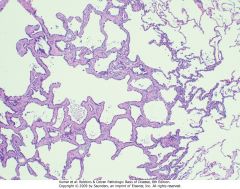
|
Atypical adenomatous hyperplasia with cuboidal epithelium and mild interstitial fibrosis.
|
|
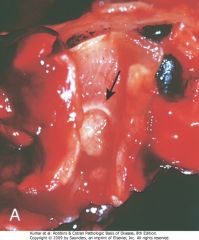
|
Bronchial carcinoid. A, Carcinoid growing as a spherical, pale mass (arrow) protruding into the lumen of the bronchus.
|
|
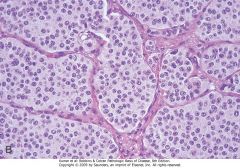
|
Bronchial carcinoid. B, Histologic appearance, demonstrating small, rounded, uniform nuclei and moderate cytoplasm.
|
|
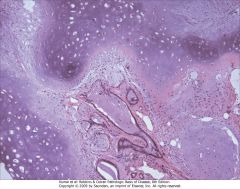
|
Pulmonary hamartoma. There are islands of cartilage and entrapped respiratory epithelium.
|
|

|
Numerous metastases to lung from a renal cell carcinoma.
|
|
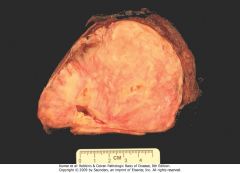
|
Solitary fibrous tumor. Cut surface is solid with a whorled appearance
|
|
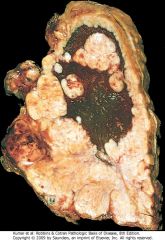
|
Malignant mesothelioma. Note the thick, firm, white pleural tumor tissue that ensheaths this bisected lung.
|
|
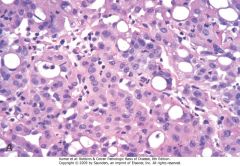
|
Histologic variants of malignant mesothelioma. A, Epithelioid type.
|
|
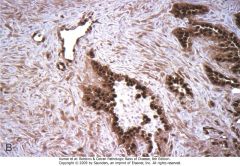
|
Histologic variants of malignant mesothelioma.B, Mixed type, stained for calretinin (immunoperoxidase method). The epithelial component is strongly positive (dark brown), while the sarcomatoid component is less so
|
|
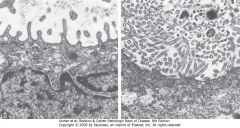
|
Ultrastructural features of pulmonary adenocarcinoma (A), characterized by short, plump microvilli, contrasted with those of mesothelioma (B), in which microvilli are numerous, long, and slender.
|
|
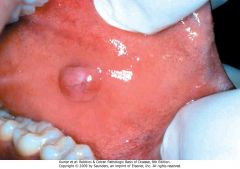
|
Fibroma. Smooth pink exophytic nodule on the buccal mucosa.
|
|
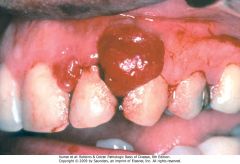
|
Pyogenic granuloma. Erythematous, hemorrhagic, and exophytic mass arising from the gingival mucosa.
|
|
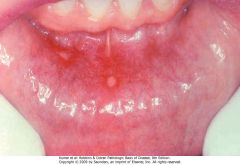
|
Aphthous ulcer. Single ulceration with an erythematous halo surrounding a yellowish fibrinopurulent membrane.
|
|
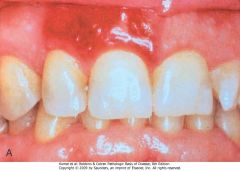
|
Erythroplakia. A, Lesion of the maxillary gingiva.
|
|
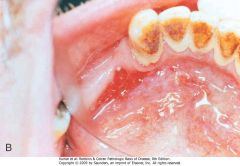
|
Erythroplakia. B, Red lesion of the mandibular alveolar ridge. Biopsy of both lesions revealed carcinoma in situ.
|
|
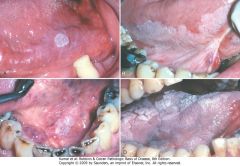
|
Leukoplakia. Clinical appearance of leukoplakias is highly variable and can range from (A) smooth and thin with well-demarcated borders, (B) diffuse and thick, (C) irregular with a granular surface, to (D) diffuse and corrugated.
|
|
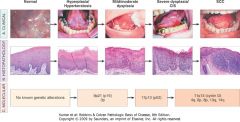
|
Clinical, histologic, and molecular progression of oral cancer. A, The typical clinical progression of oral cancer. B, The histologic progression of squamous epithelium from normal, to hyperkeratosis, to mild/moderate dysplasia, to severe dysplasia, to cancer. C, The sites of the most common genetic alterations identified as important for cancer development. CIS, carcinoma in situ; SCC, squamous cell carcinoma.
|
|
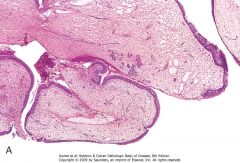
|
A, Nasal polyps. Low-power magnification showing edematous masses lined by epithelium.
|
|
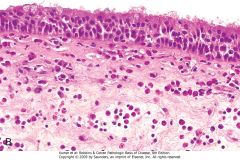
|
Nasal polyps. B, High-power view showing edema and eosinophil-rich inflammatory infiltrate.
|
|
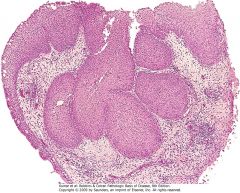
|
Inverted papilloma. The masses of squamous epithelium are growing inward; hence, the term inverted.
|
|
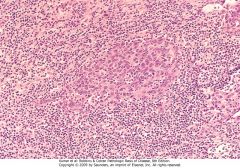
|
Nasopharyngeal carcinoma, undifferentiated type. The syncytium-like nests of epithelium are surrounded by lymphocytes.
|
|
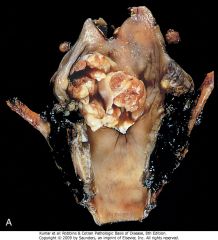
|
A, Laryngeal carcinoma. Note the large, ulcerated, fungating lesion involving the vocal cord and pyriform sinus.
|
|
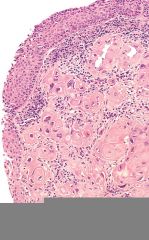
|
. |
|
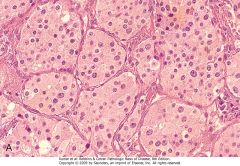
|
Carotid body tumor. A, Low-power view showing tumor clusters separated by septa (Zellballen).
|
|
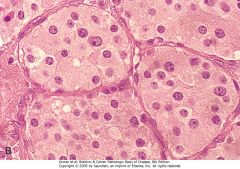
|
Carotid body tumor. B, High-power view of large, eosinophilic, slightly vacuolated tumor cells with elongated sustentacular cells in the septa.
|
|
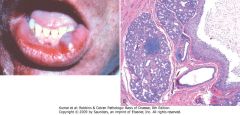
|
Mucocele. A, Fluctuant fluid-filled lesion on the lower lip subsequent to trauma. B, Cystlike cavity filled with mucinous material and lined by organizing granulation tissue.
|
|
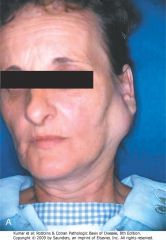
|
Pleomorphic adenoma. A, Slowly enlarging neoplasm in the parotid gland of many years duration.
|
|
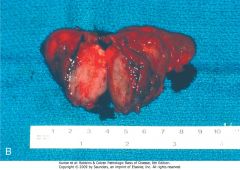
|
Pleomorphic adenoma. . B, The bisected, sharply circumscribed, yellow-white tumor can be seen surrounded by normal salivary gland tissue.
|
|
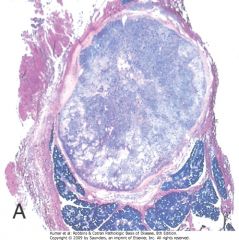
|
Pleomorphic adenoma. A, Low-power view showing a well-demarcated tumor with adjacent normal salivary gland parenchyma.
|
|
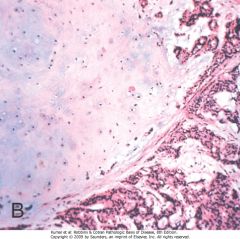
|
Pleomorphic adenoma. B, High-power view showing epithelial cells as well as myoepithelial cells found within a chondroid matrix material.
|
|
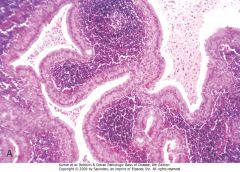
|
Warthin tumor. A, Low-power view showing epithelial and lymphoid elements. Note the follicular germinal center beneath the epithelium.
|
|
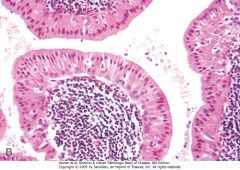
|
Warthin tumor. B, Cystic spaces separate lobules of neoplastic epithelium consisting of a double layer of eosinophilic epithelial cells based on a reactive lymphoid stroma.
|
|
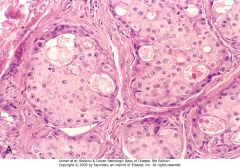
|
A, Mucoepidermoid carcinoma growing in nests composed of squamous cells as well as clear vacuolated cells containing mucin.
|
|
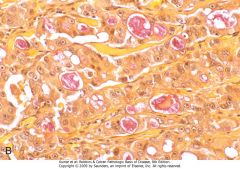
|
A, Mucoepidermoid carcinoma growing in nests composed of squamous cells as well as clear vacuolated cells containing mucin. B, Mucicarmine stains the mucin reddish pink.
|
|
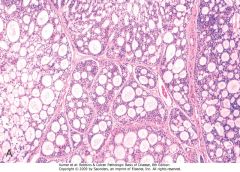
|
Adenoid cystic carcinoma in a salivary gland. A, Low-power view. The tumor cells have created a cribriform pattern enclosing secretions.
|
|
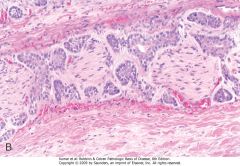
|
Adenoid cystic carcinoma in a salivary gland. B, Perineural invasion by tumor cells.
|
|

|
A, Active osteoblasts synthesizing bone matrix. The surrounding spindle cells represent osteoprogenitor cells. B, Two osteoclasts resorbing bone.
|
|

|
Woven bone (top) deposited on the surface of preexisting lamellar bone (bottom).
|
|
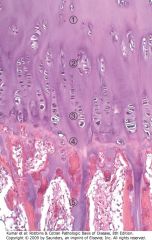
|
ctive growth plate with ongoing enchondral ossification. 1, Reserve zone. 2, Zone of proliferation. 3, Zone of hypertrophy. 4, Zone of mineralization. 5, Primary spongiosa.
|
|

|
Skeletal radiogram of a fetus with lethal type II osteogenesis imperfecta. Note the numerous fractures of virtually all bones, resulting in accordion-like shortening of the limbs.
|
|

|
Radiogram of the upper extremity in an individual with osteopetrosis. The bones are diffusely sclerotic, and the distal metaphyses of the ulna and radius are poorly formed (Erlenmeyer flask deformity).
|
|
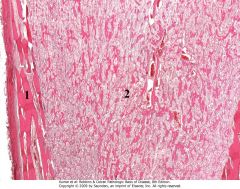
|
Section of proximal tibial diaphysis from a fetus with osteopetrosis. The cortex (1) is present, but the medullary cavity (2) is filled with primary spongiosa, which replaces the hematopoietic elements.
|
|
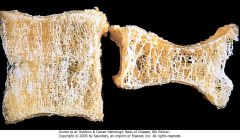
|
Osteoporotic vertebral body (right) shortened by compression fractures compared with a normal vertebral body. Note that the osteoporotic vertebra has a characteristic loss of horizontal trabeculae and thickened vertical trabeculae.
|
|

|
Mosaic pattern of lamellar bone pathognomonic of Paget disease.
|
|
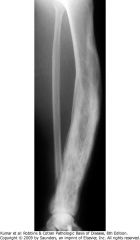
|
Severe Paget disease. The tibia is bowed and the affected portion is enlarged, sclerotic, and exhibits irregular thickening of both the cortical and cancellous bone.
|
|
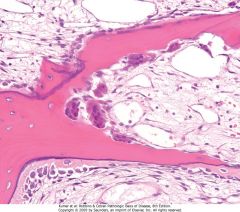
|
Hyperparathyroidism with osteoclasts boring into the center of the trabeculum (dissecting osteitis).
|
|
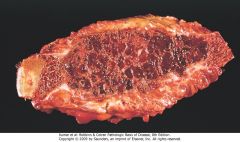
|
Resected rib, harboring an expansile brown tumor adjacent to the costal cartilage.
|
|
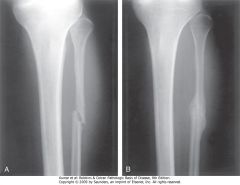
|
A, Recent fracture of the fibula. B, Marked callus formation 6 weeks later.
|
|
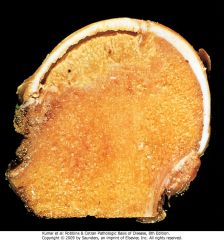
|
Femoral head with a subchondral, wedge-shaped pale yellow area of osteonecrosis. The space between the overlying articular cartilage and bone is caused by trabecular compression fractures without repair.
|
|

|
Resected femur in a person with draining osteomyelitis. The drainage tract in the subperiosteal shell of viable new bone (involucrum) reveals the inner native necrotic cortex (sequestrum).
|
|
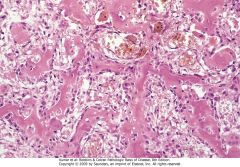
|
Osteoid osteoma composed of haphazardly interconnecting trabeculae of woven bone that are rimmed by prominent osteoblasts. The intertrabecular spaces are filled by vascularized loose connective tissue.
|
|
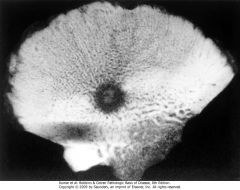
|
Specimen radiogram of intracortical osteoid osteoma. The round radiolucency with central mineralization represents the lesion and is surrounded by abundant reactive bone that has massively thickened the cortex.
|
|
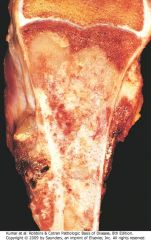
|
Osteosarcoma of the upper end of the tibia. The tan-white tumor fills most of the medullary cavity of the metaphysis and proximal diaphysis. It has infiltrated through the cortex, lifted the periosteum, and formed soft-tissue masses on both sides of the bone.
|
|

|
Coarse, lacelike pattern of neoplastic bone produced by anaplastic malignant tumor cells. Note the mitotic figures.
|
|
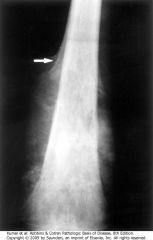
|
Distal femoral osteosarcoma with prominent bone formation extending into the soft tissues. The periosteum, which has been lifted, has laid down a proximal triangular shell of reactive bone known as a Codman triangle (arrow).
|
|

|
Osteochondroma. A, X-ray of an osteochondroma arising off the posterior surface of the tibia. B, Axial CT scan shows continuity of the cortex of the bone and the center of the osteochondroma. The fibula is adjacent to the mass. C, Gross specimen of sessile osteochondroma composed of a cap of hyaline cartilage undergoing enchondral ossification. D, The cartilage cap has the histologic appearance of disorganized growth plate-like cartilage.
|
|
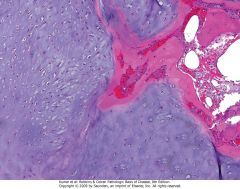
|
Enchondroma with a nodule of hyaline cartilage encased by a thin layer of reactive bone.
|
|
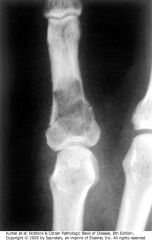
|
Enchondroma of the phalanx with a pathologic fracture. The radiolucent nodules of hyaline cartilage scallop the endosteal surface.
|
|
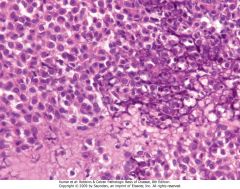
|
Chondroblastoma with scant mineralized matrix surrounding chondroblasts in a chicken wire-like fashion.
|
|

|
Chondromyxoid fibroma with prominent stellate and spindle cells surrounded by myxoid matrix. Occasional osteoclast-type giant cells are also present.
|
|
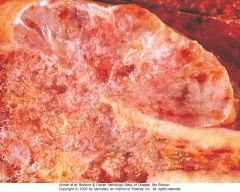
|
Chondrosarcoma with lobules of hyaline and myxoid cartilage permeating throughout the medullary cavity, growing through the cortex, and forming a relatively well-circumscribed soft-tissue mass.
|
|
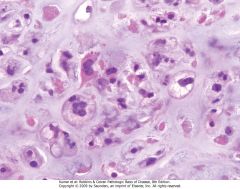
|
Anaplastic chondrocytes within a chondrosarcoma.
|
|
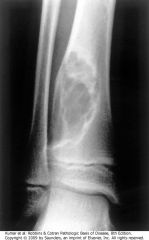
|
Non-ossifying fibroma of the distal tibial metaphysis producing an eccentric lobulated radiolucency surrounded by a sclerotic margin.
|
|

|
Storiform pattern created by benign spindle cells with scattered osteoclast-type giant cells characteristic of a fibrous cortical defect and non-ossifying fibroma.
|
|

|
Fibrous dysplasia composed of curvilinear trabeculae of woven bone that lack conspicuous osteoblastic rimming and arise in a background of fibrous tissue.
|
|
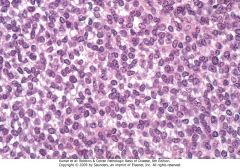
|
Ewing sarcoma composed of sheets of small round cells with small amounts of clear cytoplasm.
|
|
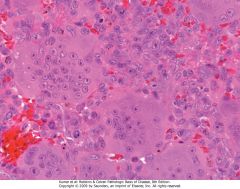
|
Benign giant-cell tumor illustrating an abundance of multinucleated giant cells with background mononuclear stromal cells.
|
|

|
Magnetic resonance image of a giant-cell tumor that replaces most of the femoral condyle and extends to the subchondral bone plate.
|
|

|
Aneurysmal bone cyst with blood-filled cystic space surrounded by wall containing proliferating fibroblasts, reactive woven bone, and osteoclast-type giant cells.
|
|
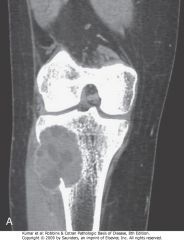
|
A, Coronal computed axial tomography scan showing eccentric aneurysmal bone cyst of tibia. The soft-tissue component is delineated by a thin rim of reactive subperiosteal bone.
|
|
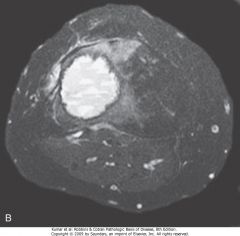
|
eccentric aneurysmal bone cyst of tibia. B, Axial magnetic resonance image demonstrating characteristic fluid-fluid levels.
|
|
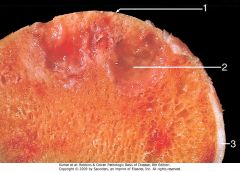
|
Severe osteoarthritis with small islands of residual articular cartilage next to exposed subchondral bone. 1, Eburnated articular surface. 2, Subchondral cyst. 3, Residual articular cartilage.
|
|
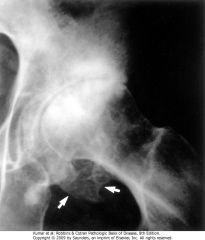
|
Severe osteoarthritis of the hip. The joint space is narrowed, and there is subchondral sclerosis with scattered oval radiolucent cysts and peripheral osteophyte lipping (arrows).
|
|
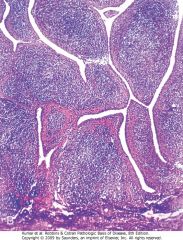
|
Rheumatoid arthritis. B, Low magnification reveals marked synovial hypertrophy with formation of villi.
|
|

|
Rheumatoid arthritis. C, At higher magnification, subsynovial tissue containing a dense lymphoid aggregate is seen.
|
|
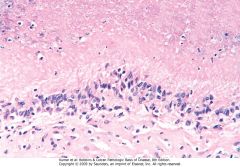
|
Subcutaneous rheumatoid nodule with an area of necrosis (top) surrounded by a palisade of macrophages and scattered chronic inflammatory cells.
|
|

|
Rheumatoid arthritis of the hand. There is diffuse osteopenia, marked loss of the joint spaces of the carpal, metacarpal, phalangeal, and interphalangeal joints, periarticular bony erosions, and ulnar drift of the fingers.
|
|
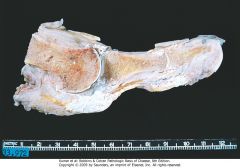
|
Amputated great toe with white tophi involving the joint and soft tissues.
|
|
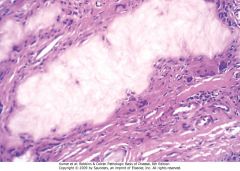
|
Photomicrograph of a gouty tophus. An aggregate of dissolved urate crystals is surrounded by reactive fibroblasts, mononuclear inflammatory cells, and giant cells.
|
|
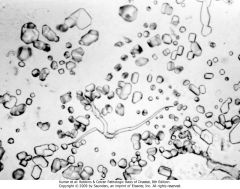
|
Smear preparation of calcium pyrophosphate crystals.
|
|
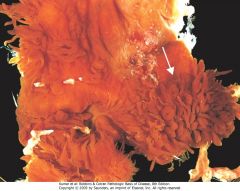
|
Excised synovium with fronds and nodules typical of pigmented villonodular synovitis (arrow).
|
|
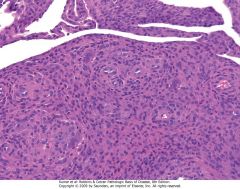
|
Sheets of proliferating cells in tenosynovial giant cell tumor bulging the synovial lining.
|
|
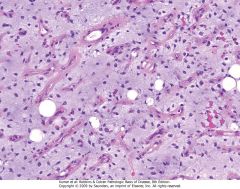
|
Myxoid liposarcoma with abundant ground substance in which are scattered adult-appearing fat cells and more primitive cells, some containing small lipid vacuoles (lipoblasts).
|
|
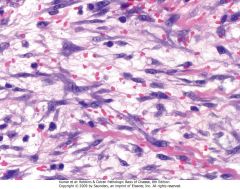
|
Nodular fasciitis with plump, randomly oriented spindle cells surrounded by myxoid stroma. Note the mitotic activity and extravasated red blood cells.
|
|
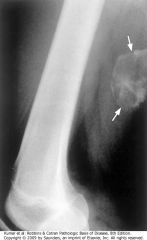
|
Peripherally mineralized myositis ossificans (arrows) involving the posterior thigh.
|
|

|
Fibromatosis infiltrating between skeletal muscle cells.
|
|
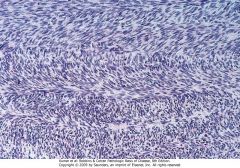
|
Fibrosarcoma composed of malignant spindle cells arranged in a herringbone pattern.
|
|
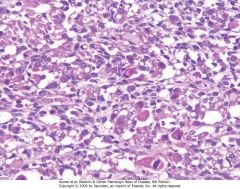
|
Rhabdomyosarcoma composed of malignant small round cells. The rhabdomyoblasts are large and round, and have abundant eosinophilic cytoplasm; no cross-striations are evident.
|
|
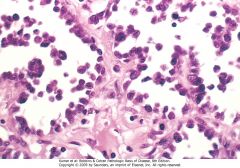
|
Alveolar rhabdomyosarcoma with numerous spaces lined by tumor cells.
|
|
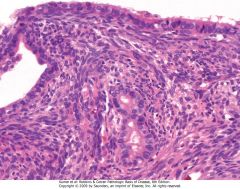
|
Synovial sarcoma revealing the classic biphasic spindle cell and glandular-like histologic appearance.
|
|
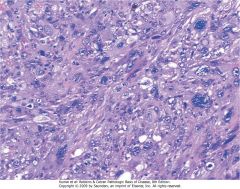
|
Pleomorphic fibrosarcoma revealing fascicles of plump spindled cells in a swirling (storiform) pattern, typical but not pathognomonic of this neoplasm.
|

